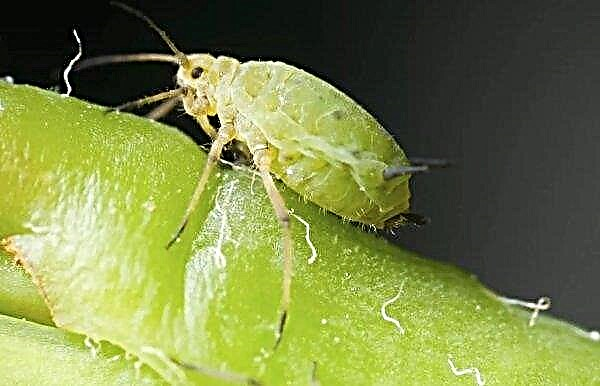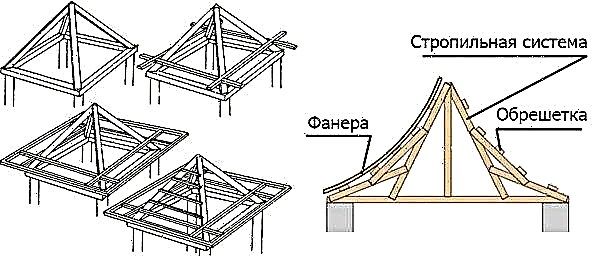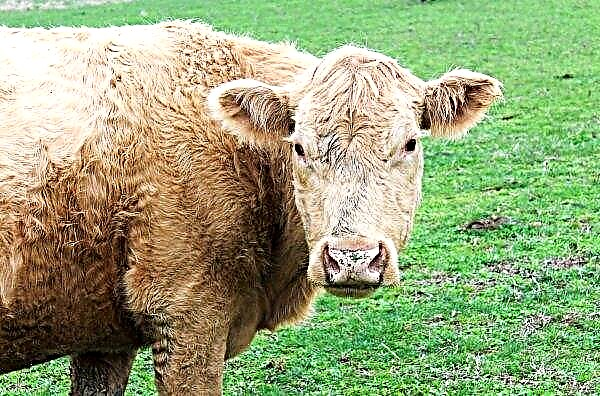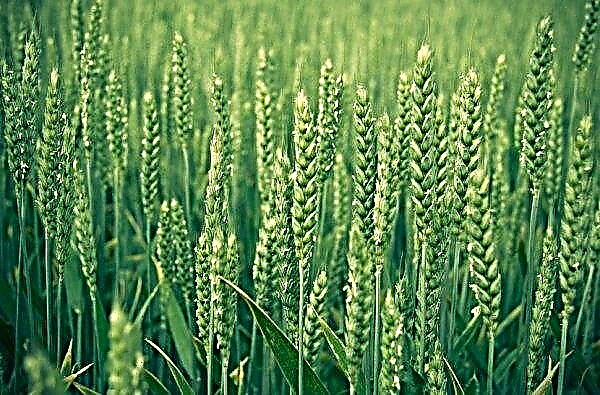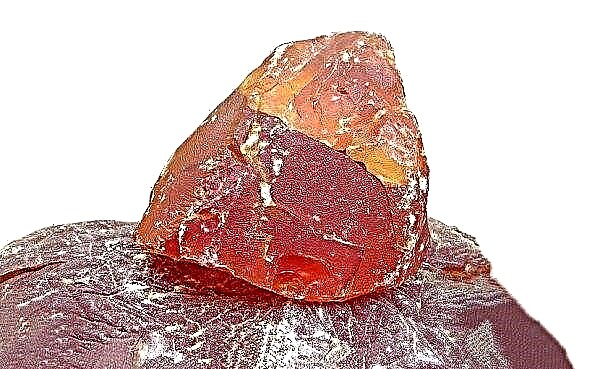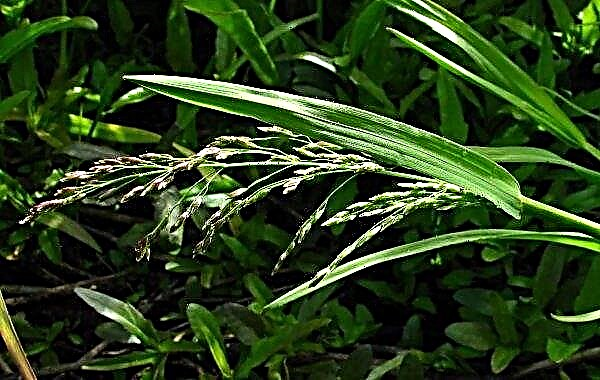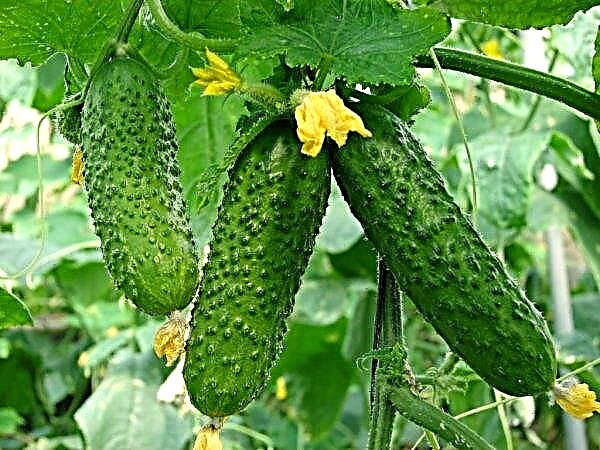Variety Smaragd is considered to be the best of the conical varieties of unpretentious and beautiful western thuja (Thuja occidentalis). The presence on the site of this tree will add solidity and well-groomedness to the general plan of the house adjoining territory and will be useful when zoning it.
Breeders from the Netherlands used the strength of the characteristics of “Emerald” and recently created on its basis a new line of two-color arborvitae. Sunny Smaragd stands out especially: a spectacular combination of the superior qualities of the predecessor with striking, sunny shades of color, deservedly brought him popularity.
Grade description
The correct pointed form, dense crown and thick evergreen needles, beyond which the trunk is not visible, are inherited by a variety from the ancestor. Of the common features - durability of thuja, resistance to wind, the need for moderate humidity and intolerance to acidified and alkaline soil. The root system is superficial.
 A valuable feature of Sunny Smaragd is the color of the needles: the young growth is initially bright yellow with orange tips of scales, only matured branches will become emerald over the years.
A valuable feature of Sunny Smaragd is the color of the needles: the young growth is initially bright yellow with orange tips of scales, only matured branches will become emerald over the years.
Thick numerous skeletal branches are flat and directed upwards. The height of the new variety is slightly inferior to the previous one, the medium-tall (semi-dwarf) Sunny by the first decade of life will not exceed 3 m. At the same time, its growth rate is tripled: instead of 10 cm per year, as the ancestor of the group “Emeralds” (as it sounds in the translation “Smaragd” ), this species grows by 30 cm.
It is difficult to call Krona miniature, although it is narrower than that of many representatives of conifers - up to 1.5 m in diameter. A slight deterioration in frost resistance makes us more attentive to the problem of wintering a tree: frosts below -23 ° C without shelter are fatal to it. Otherwise, this novelty is not too picky: direct access to the sun with possible easy shading, fertile loose earth and regular pruning will fully reveal the beauty of Sunny Smaragd.
Did you know? Thuja cones and needles are used as an additive to enrich the diet of parrots, and excellent “furniture” for these birds comes out of its soft wood.
Application in landscape design
From a dozen or two years ago, coniferous plantations were found only at state institutions, now without compact, beautifully formed, bright varieties of thuja it is difficult to imagine any corner of relaxation, whether it be a square, a playground, a hotel or a restaurant.
 The originality of the yellow accent of this variety immediately attracted the designers.
The originality of the yellow accent of this variety immediately attracted the designers.
Sunny Smaragd looks good apart, but is beautiful in a group of similar and deciduous plantings. Coniferous homogeneous green shrubs or trees nearby shade its golden charm: fir, juniper, dwarf pine, conical spruce will be well located nearby. Larch also well emphasizes the tenderness and velvet needles.
Check out

If you plant this view in large-scale containers on both sides of the massive porch, you will get an imitation of the classical geometry of the palace, and a single landing of a thuja at the front door of a small house will give warmth and comfort.
A tree planted near a hill rock garden or rockery will modify them for the better.
The thick and lush cap of the tops suggests a wide choice of fulfilling the dream of living garden figures: the possibilities of picturesquely forming a crown at your discretion are numerous.
Do not limit yourself to the spirals that designers most often offer because of their simplicity. The compatibility of the Sunny Smaragd variety with flowering perennials is admirable. Bushes of jasmine, rhododendron, hydrangea set off the natural aesthetics of thuja plantings; Lupins, azaleas, tulips, Asiatic lilies and astilbe, located nearby, look like a win-win. In the near-stem circle it is appropriate to plant small flowers (lilies of the valley and marsh violet) and creeping plants (heather, frankincense and tenacity).

Thuja will help to completely transform the alley. When the branches thicken as they grow, they ideally fulfill the role of a hedge. Their relatively large width and height requires each trunk to be placed at a minimum distance of 1 m - otherwise tightness during the accumulation of large trees will force the planting to thin out after 2-3 years.
Consider the factors of rapid branch growth, a meter and a half span of the crown and a painful plant transplantwhich is not always technically possible, and plan your conifers in the garden in advance. Decide if there is a need to preserve the natural pyramidal shape of the variety - after some time, such a planting turns into a dense array of greenery without gaps and cones out of the row.

Do not lose sight of the place that must be left for free movement around when caring for the plant: he will need a curly haircut, watering, sanitation, strapping. If there is a problem with the prevailing direction of constant winds, use thujas as a protection against dust storms. Phytoncides, which they secrete, enrich the air and have a therapeutic effect, so these plants will be useful in crowded places.
Did you know? In the world, 21 long-lived trees have been recorded, whose age exceeded 1.5 thousand years, while 20 of them belong to the coniferous family.
How to plant
When deciding to create a hedge, do not bring the landing sites together. To do this, it is better to mark two rows and place marks for digging holes in a checkerboard pattern. Then the trees during growth will completely hide the garden and will not interfere with the growth of the rest. Close landing in one row will lead to the impossibility of caring for them and deforms adjacent crowns.
In this semi-dwarf variety, the roots deepen by a meter only when they reach the age of three, during this period there should be enough nutrition from the soil. Consider the preference of a neutral or slightly acidic environment - wet alumina of medium density is suitable. The rich fertile layer of leaf turf is also good for thuja. In addition, it is porous, retains moisture well, slightly acidic and easy to process.

It is necessary to prepare a place for planting in advance if sand, peat, dry heavy loams prevail on the site. If this is not done, the needles will quickly turn brown, the development lag will begin, it is possible to dry and fall off entire branches, which will lead to death.
Features of preparation:
- equal parts of peat and sand mixed with half of the dug up earth will improve clay soil;
- for sandy areas, replace half of the extracted clods with peat and loam equally;
- peatlands can be improved by mixing in equal proportions with sand and alumina. If this is not possible, use the ready-made mix for conifers from the store.
Landing time
The best survival rates in Sunny Smaragd are observed in late spring. In the northern parts of the country, experts recommend waiting for the start of summer. Excessive dampness and a sharp cooling in March - early April can lead to disastrous results: an immature tree will not survive. However, warm weather does not always affect rapid rooting.

If the store neglected the timely delivery of water and did not comply with the required amount, the thuja will show stress during transplantation: after two weeks the green scales of the needles turn brown inside, the root system slowly restores strength. During this period, do not feed the weakened plant with fertilizers, shade from heat, prevent infection with aphids or ticks and regularly water it.
Avoid landing in extreme heat without rain - The increased evaporation of moisture will not allow rooting if you forget to water it at least once. Autumn planting experiments are permissible only in the southern regions, this conifer will need 2-3 months to take root before the onset of frost. In violation of agricultural technology, he is ill for a very long time and is poorly accepted.
Important! The resistance of the thuja is deceptive: the needles can remain green for a long time after the death of the plant. To establish a state will help the appearance of a new yellow growth or its absence.
Propagation by cuttings will not cause difficulties, although such specimens grow for a long time - a half-meter bush can be obtained in 5 years. Rooting is conveniently done after April or May haircuts; this will require the creation of greenhouse conditions under the film at room temperature. Universal rooting soil is suitable, just add part of vermiculite (10–20% of the volume) and the same sand to it.
Moisturize a seedling by spraying water in a greenhouse. Ventilate the greenhouse regularly, remove accumulated condensate. Root formation will occur in a month. If the result is favorable, keep the plant in a container, for the winter cleaning in a greenhouse with heating or on a warm balcony.
 In the 6th year of life, such a bush can be planted in open ground.
In the 6th year of life, such a bush can be planted in open ground.
The choice of seedlings and places for planting
The demand for unusual views when planning parks, gardens and large suburban areas has grown so much that even wholesalers and garden centers do not always have time to satisfy it.
It is better to order the required sizes and the number of cuttings from autumn for spring acquisition. Such planting material is sold in cassettes or in P9 pots for small seedlings about 40 cm high; there are offers and full-fledged trees in containers.

Always evaluate the condition of the seedlings before purchase according to the criteria inherent in healthy specimens:
- the size of the plant does not exceed 1–1.2 m, this will take root better;
- the needles are bright yellow and emerald, resilient;
- trunk and skeletal branches of a uniform reddish tone without deformation and spots;
- there are no browned spots or bald spots in the crown; the color corresponds to the variety.
- the bark is homogeneous and does not contain cracks and holes that indicate damage by pests;
- the soil in the sales container is moderately moist, not dry and not poured;
- open roots are healthy, powerful, strong, flexible, terracotta-colored, without rot and mold, they are not brittle, dry branches.
Think carefully about the issue of permanent habitat. Tui can not tolerate transplantation, so it is advisable to immediately exclude a temporary place for them. If an emergency arose, transplant, but maintain the integrity of the root system and make sure that the season allows it. The landing area should be sunny. Thuja needs full sun at least 4 hours a day. The two-tone subspecies Sunny Smaragd will not lose the saturation of colors in the shade, but it will significantly slow down the growth rate.
Important! When planting, avoid the close proximity of other strong-growing shrubs and trees, especially one where there is noticeable shading, otherwise the crown will form with a warp.
Phased landing
Once you have decided on the location and prepared the components of the soil mixture, proceed to transplant coniferous seedlings:
- Get rid of weeds with a strong rhizome, dig a prepared place, dig a planting hole 1 × 1 m.
- Provide drainage to the bottom of the landing pit. A layer of 10 cm of gravel, crushed stone or brick chips will be enough.
- Pour the prepared soil into the planting recess. Make a deepening in loose soil 30 cm larger than the diameter and 10 cm lower than the root system of the seedling.
- Moisten the soil in a container with a seedling, from where it is then carefully removed and placed in the center of the hole, straightening the roots.
- Raise the root neck 2-3 cm above the soil level, taking into account the estimated subsidence of the land cover. Its excessive deepening will lead to decay from dampness.
- Mix the soil remaining from digging a hole with humus in a 1: 1 ratio.
- Pour the finished mixture into the recess around the seedling, ramming it with your hands at the roots. Avoid compaction of soil near the trunk.
- Form an earthen barrier 5-6 cm high in the near-stem radius to keep water within the roots when watering. In case of landing of the conifer on a hillside, increase the upper part of the obstacle.
- Mulch with pine bark, wood chips, straw immediately after planting.

Please note that the straw breaks, does not save from weeds and decomposes as soon as possible, monitor its condition. It is impossible to dry the tree, so it is important to create a coating that retains moisture. However it’s not worth hiding the ground near the trunk itself under a layer of mulch - in wet weather, the chances of its aging and rotting will increase.
Care
Sunny Smaragd, in addition to increased photophilia, differs from the old varieties of the Smaragd group by the accelerated growth rate and lower winter hardiness.
To preserve beauty, it requires a little more attention than the rest:
- instability to drought leads to frequent watering;
- gentle needles oblige to create a protective screen for shading from the March rays of the sun;
- rapid growth more intensively depletes the soil, so fertilizing is necessary;
- pests noticeably spoil the increased decorative effect, because of which there is a need for preventive treatment with insecticides;
- wide crown needs regular pruning;
- density dictates the condition to find and remove broken and fallen branches, as well as aged brown needles near the trunk, most often in autumn;
- a decrease in resistance to frost will make it necessary to cover the tree in cold winters.
However, this variety does not need any special growing conditions.
Important! DEven completely dead needles do not crumble on their own. Remove branches with a potential source of disease manually.
Watering and fertilizer
The first time after planting for a month, provide the conifer with regular watering. In the absence of rain, focus on weekly irrigation - it can grow in open ground only in a moist and nutrient environment. In a flowerpot, moisture requirements increase. Any overdrying is unacceptable and will lead to the death of the young cuttings.
Difficulties with watering often arise due to the lack of a signal of dryness - the needles do not fade like deciduous trees, but immediately brown and dry with whole branches falling off when the roots gradually die off. Regulate the abundance of water, it depends on the age of the plant and the weather conditions of the area.
 The roots should get wet completely, and not in places, otherwise the branches will begin to dry in those places where there was not enough moisture.
The roots should get wet completely, and not in places, otherwise the branches will begin to dry in those places where there was not enough moisture.
In an open sunny area, the frequency and intensity of moisture application will increase. So, at one time a meter-long tree will need 10-15 l, coniferous trees up to 2 m need 20-30 l, and an adult - at least 50 l. To facilitate operation, leave a hose with a medium flow head for 2 hours in the trunk circle.
Tui love scattered watering and humid air. In the evening, it is not superfluous to rinse the dust from the branches from the hose so that the sun does not burn needles under the drops, which will create a lens effect in the rays. Avoid this process, if there is a fungal infection, it is better to just shed the root layer.

Fertilize only after sufficiently moistened the groundso as not to burn the roots, for the same reason it is not recommended to exceed the dosage of mineral-organic complexes. Fertilizing is unnecessary and can even do harm in the first two years after planting, if nutrients were introduced simultaneously with the seedling. Thuja Sunny Smaragd adds well in growth, so there is no point in accelerating it additionally.
To ensure that nutrition is beneficial, remember that:
- an excess of nitrogen-containing fertilizer is contraindicated in conifers;
- you can not use fresh mullein, chicken droppings, not rotted manure;
- leaf humus is perfect, 3-year-old manure, it is applied in an amount of 10-15 l in spring as a mulching layer;
- special nutrient solutions for conifers, or universal, containing a small amount of nitrogen, exist and have proven themselves, for example, Kemira Wagon (20 g per meter trunk, 40 g per 2 m, 50 g per adult);
- thuja is fed once every 2 months, the last feeding is carried out in August, in the autumn feeding is prohibited.
Did you know? Northern white cedar, eastern white cedar, tree of life, marsh cedar — just commercial names for thuja western, invented nurseries in order to increase sales.
Loosening
This species is quite sensitive to the density of the upper layer of the earth. Without an influx of oxygen to the roots, small seedlings can wither away. Once a year, in the spring, after cleaning the insulation from leaves or spruce branches, it is necessary to slightly loosen the trunk space, without deepening glanders lower than 10 cm. The root system in young plants does not exceed 50-60 cm in diameter and is located not far from the surface. It is important not to disturb her, avoiding damage to the garden tool.
 In older trees, it is advisable to carefully remove the top layer of the earth, and instead put 7-10 cm of humus, compost, pine bark. Be careful with the latter: its constant use acidifies the soil, which thujas cannot tolerate.
In older trees, it is advisable to carefully remove the top layer of the earth, and instead put 7-10 cm of humus, compost, pine bark. Be careful with the latter: its constant use acidifies the soil, which thujas cannot tolerate.
Make sure that the mulching does not turn into a swelling. - the root neck should remain open, and the space under the tree is moist and without weeds. To do this, annual cultivation is carried out and the mulch is renewed, improving the structure and fertile soil layer.
Did you know? Thuja needles essential oil was used for the cult rituals of the Indians, and wood served as a building material for their canoes.
Pruning
All western arborvitae are well tolerated for pruning, and in the considered variety, regular haircut will cause intensive growth, give needles brightness and density. In order to preserve the geometric shapes of the pyramid, cone, ball and well-groomed appearance, Sunny Smaragd needs annual pruning of branches.

Sometimes newly acquired seedlings require a reduction in leading trunks, if there are more than one. Choose columnar plants in advance without a similar problem. If there is no choice, boldly cut, placing against the light, the trunk that looks weaker - the crown will recover during the season, and the tree will no longer be bald and one-sided.
The fast-growing Sunny must be cut twice; The shape of a ball or an egg will require two main stages of pruning and frequent small, cosmetic ones, if the branches are knocked out of the general array and spoil the geometry. When cutting, consider the future diameter of the branches at the base of the trunk - in this case, the final size will be 1.5 m.

Keep these proportions, because the increase will not exceed 10 cm in width, while the seedling will rise by a third meter in height. Take into account the perspective of the garden and the type of thuja in ten years, an adult tree cannot be transplanted. Shorten the branches by no more than a third, in the spring, when the buds open. Remove dried and broken branches.
This variety is plastic, therefore, giving it a spiral shape that is favorite among decorators is not difficult:
- Prepare pruning shears, clippers, rope.
- If the tree is tall, take care of the appropriate length of the blades and handles of the garden tool. Electric inventory options will cut the haircut by half.
- Tie several trunks in one straight, so the spiral will take on a spectacular look.
- Tie the rope with one end to the top of the head, wrap it with tight spiral turns around the tree, fix the second end at the base.
- Do not go deep into the trunk in the first pruning, just outline the outline, leaving branches for further adjustment.
- Walk the secateurs a second time along the needles parallel to the rope, gradually plunging into the crown.
- “Epin” or “Zircon” preparations will cause a good growth, therefore, immediately after cutting, treat them with the formed tree.
Proper wintering
Leading Polish and Dutch nursery producers recommend growing this species in regions where the temperature does not drop below -23 ° C, then the conifer will survive the winter without shelter. General recommendations require clarification, because new varieties of these trees are more tender and demanding. Snow, under which the plant hibernates better, can break soft branches, icing will damage a beautiful hat, and winds will break the trunk.

Therefore, from November, you need to take care of protection from the cold:
- Select the dead needles inside the crown, cut off the dry parts.
- Before frost in the autumn, spill the plant deeper than usual. Repeat abundant watering with the disappearance of snow cover.
- So that the snow does not linger on vertically directed branches and flies down, be sure to bind them with twine or capron in several places, but do not tighten it tightly - the needles will vanish, get brown, will suffer a fungal disease.
- Mulch the basal part with lapnik, fallen leaves or peat. In cold and snowy winter, snow will fit as mulch.
- Very young specimens up to 1.5 m in length will not save caps from ice and snow from the load, for them they will have to build a hut from a rack wooden tripod and wrap it with non-woven white fiber.
- A frame shelter or screen will protect adult trees from burning under the bright rays of the February and March sun after cloudy months.
Despite the love of the sun, Sunny Smaragd is very susceptible to burns of the crown, especially in late winter and early spring with a dangerous snowless period. He will not burn in case of complete shelter with snow of a young or stunted plant, formed spherical. Therefore, it will not be amiss to take into account the amount of precipitation, the prevailing climate and weather conditions, when the time comes to prepare the tree for wintering.
Important! Avoid wrapping wood with polyethylene, burlap, or kraft paper. — this will lead to the loss of a seedling! Use camouflage netting, gauze or cotton in the absence of lutrasil.
A thick and elegant, easily amenable to the most unusual haircut, thuja varieties Sunny Smaragd have the prospect of quickly gaining popularity and replacing common varieties. If you are ready to pay a little more attention to the novelty than what the conifers require, this variety will open in all its glory in a few years. The evergreen needles with a sunny color will delight the most demanding gardener and will delight you with an attractive view for many years.

